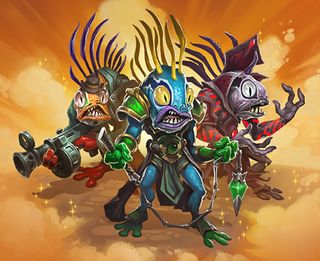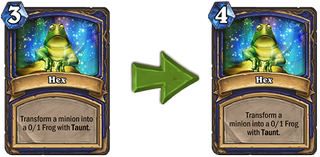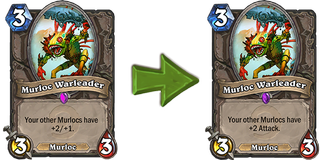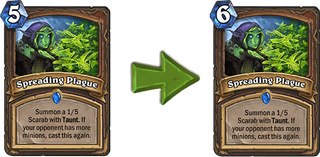How Hearthstone's major balance patch will shake up the meta
Five cards are being changed, but many more decks will be affected.

Seeing the news of the balance patch yesterday threw a lot of what I have known about Hearthstone for the last several years out the window. The closest analogy I could draw to seeing these changes is like coming home to find your house has been remodeled in some major ways. The renovations might be nice overall, but it’s a lot to take in. There’s a long history in your house, so seeing a different version than the one you’ve known forever feels strange.
Nevertheless, I want to press ahead past that strangeness and nostalgia, assess the changes coming to the cards, and think about what their impact on the meta is likely to be. Or do my best, anyway.

Innervate
The impact of this change is hard to overstate. Druid has always been a good class, largely due to the power level of this card. Innervate has gone from being arguably the best card in the game to a much more middling power level. The obvious comparison is now with Counterfeit Coin, which doesn’t usually see play outside of Miracle decks. However, since it doesn’t possess the Combo mechanic, Druid gets a lot less out of Innervate than Rogue does out of Coin. Since Coin has only ever seen play in certain kinds of Rogue decks, it seems unlikely that non-Miracle versions of Druid would want to include Innervate anymore. It’s hard to halve the power level of a card and expect it to still be viable.
As every Druid deck played two copies of Innervate, this is a shot to all class archetypes. Jade Druid will no longer be able to accelerate out their large threats (or ramp) as effectively, nor will they be able to play cards after casting Ultimate Infestation. Aggro Druid will no longer be able to steal games with turn one Vicious Fledglings or turn two/three Bittertide Hydra. That said, I don’t think this change alone makes either deck bad. It just makes them weaker than they were.

Fiery War Axe
Speaking of the best cards in the game, War Axe has long been a class- and game-defining card. It gave Warriors access to the best tempo and damage tool in the game. The upcoming changes now make it worse than other three-cost weapons which had been balanced around the power level of War Axe. That said, a three-cost, 3/2 weapon is not bad. Rallying Blade and Eaglehorn Bow do have some upsides compared to the new Axe, but they were rarely played because of them. All those weapons were included largely because a 3 cost War Axe is still a good card. The upsides were just icing on the cake.
The impacts of this nerf are larger than the above considerations might lead one to believe, though. First and foremost, it is a major blow to Pirate Warrior’s strength. The three-slot is already fairly clogged and the two-slot largely empty. Bloodsail Raider becomes a lot worse in general (and on the coin specifically), as does every upgrade effect Warriors run. It’s going to be much trickier to hold onto an early board for a Bloodsail Cultist buff, for example. Control Warrior lists are somewhat less affected, but the ability to stop early pressure being hampered and their clogged three-slot still matter a lot to them.
This change might make the Warrior class bad, at least for now, but it’s hard to tell.
PC Gamer Newsletter
Sign up to get the best content of the week, and great gaming deals, as picked by the editors.

Hex
This change is much less dramatic. While Hex has always been some of the best removal in the game, it hasn’t really defined the class the way Innervate or War Axe did. In fact, at 4 Mana Hex is still a reasonable card, comparable to removal like Polymorph.
Since Hex wasn’t currently seeing play, this change will likely go unnoticed as far as the meta is concerned (not unlike when Warrior’s Charge got reworked). It might be the kind of thing that gets felt more in the future, but for now it shouldn’t affect the game much.

Murloc Warleader
The removal of the health buff offered by Warleader is a larger deal than some people think. The attack buff of Warleader allowed for large damage pushes or trading up into opposing minions, quite like Flametongue Totem does. However, the health buff allowed your murlocs to survive those trades and subsequent AoE. As the murloc tribe is built around having murlocs on board, the ability of Warleader to help you maintain a board for subsequent synergies was a key feature of its power. This change doesn’t make Warleader worse as much as it makes every murloc in your deck worse.
Does that mean Murloc decks will be bad now? Hard to say, but it certainly makes them appreciably weaker than they were. Murloc decks will still assuredly play Warleaders. The question is whether those decks are better than their competitors. Since we’re seeing them in Paladin currently, it’s a matter of whether they will outperform Handbuff lists, which they might not.

Spreading Plague
This was the card I had thought should have been changed the most. It was simply too effective at counteracting a major historical weakness of the Druid class to wide, aggressive boards (as a recent analysis by HSreplay showed), which was a key in spiking Jade’s popularity. By making the card weaker, Jade Druid should hopefully develop some more bad matchups, which will discourage it from being played as often. Less Jade Druid allows other decks to arise that can counter those weakness more effectively. This helps reintroduce some the rock-paper-scissors elements to matches that keeps the meta balanced and dynamic.
Again, this change alone probably doesn’t make Jade Druid bad. It just turns it into less of an oppressive force for the game in terms of overall power level. Which is good all around. In fact, depending on what the meta looks like, Spreading Plague might even still see play, though perhaps as a one-of instead. This change is not nearly as dramatic as the others.
The meta impacts
Now for the hardest part: figuring out the probable impact on the meta of all these changes. The meta is like a complex ecosystem and some key species just went extinct. Predicting the full extent of the changes that are about to hit us is near impossible.
Several aggressive decks just got worse: Pirate Warriors, Murloc Paladins, and Aggro Druids (in decreasing order of severity). This does not necessarily imply that they will be bad, but the current lists will certainly be weaker. That said, for those thinking that Aggro got a nerf, I’d say you’d be better off taking a more reserved stance. The archetype of aggressive decks will assuredly remain in the game, even if they are not the same ones we’ve been seeing. There are also other aggressive decks that will come to exist that did (or could) not do well previously. For instance, I have a successful Pirate Rogue list that will go untouched and was doing fine in the current meta. It is possible that an aggressive deck like that—one that is only modestly worse than current options—will come to be a more common sight in the upcoming meta. Zoo and Secret Mage are always strong contenders for that role.

With Jade Druid nerfed, Razakus Priest—a powerful control deck built around Raza the Chained, Kazakus, and Shadowreaper Anduin—has a good chance to reign supreme.
Next—and crucially—we need to bear in mind what didn’t get nerfed: Mage, Warlock, Rogue, Priest, and Hunter (Shaman, too, to a lesser extent). As the recent European Preliminary tournament demonstrates, Raza Priest is a strong contender as a deck when you can ban out Jade Druid. With the changes to current aggressive decks and the nerf to Innervate, I’ve seen many people concerned that Priest will now become too strong as it remains untouched while its major predators have been hit.
It’s a thought process that sounds plausible, but you should remember, as mentioned previously, that new decks will likely arise that couldn’t exist in the previous meta. It’s not just Priest that goes untouched. Perhaps the new changes make Rogue a lot better too, which can then be designed to counter Priest effectively. Perhaps an aggressive Secret Mage arises that hurts Rogue more than the previous aggressive decks did. Maybe the meta slows down and Quest Mage gets better, but then maybe we see Zoo or Hunter returning as the go-to aggressive lists when decks like Pirate Warrior and Aggro Druid don’t keep them down as hard.
The point of all this is simply to drive home the idea that these changes cannot be adequately evaluated just by looking at the decks that are good right now. These changes are going to be massively impactful in terms of what decks can exist now and into the future, and we don’t know what those decks will be yet.
Given the core nature of these nerf targets, this balance patch will—in a very real sense—be like getting an entirely new expansion (perhaps a small one, but new content all the same). If there’s one thing you can be certain of, it’s that the impacts on the meta from these changes will be different than what you will imagine them to be.
Most Popular

